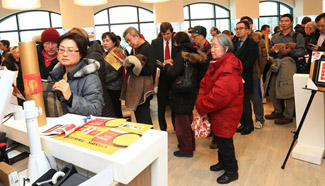BEIJING, Jan. 16 (Xinhua) -- From steam locomotive and diesel trains to electric locomotives and high-speed rail, Du Ronghua has seen China's train speeds soar from 60 to 300 km per hour.
Du, 45, has been working as a train operator in the eastern city of Hangzhou since 1991. For him, nothing illustrates the rapid development of the country's railway system quite like "chunyun," the annual Chinese Spring Festival travel rush.
Recalling chunyun during the era of diesel trains, Du said, "It was hard for the train to start when parked at the station, as flocks of passengers would rush to the train and some would even stand on the door steps when they were unable to squeeze inside."
High speed rail has dramatically increased the capacity and efficiency of China's railways, and passengers now have a more comfortable experience, even amid the chunyun crowds, he said.
China's high-speed railways have seen rapid expansion in recent years. The country boasts a high-speed rail network of more than 20,000 km, the world's largest.
Du still remembers a time back in the 1990s when his steam train passed a tourist train. Several foreigners took out their cameras to take pictures of the old-fashioned train with curiosity.
"I was so embarrassed at that moment," he said. Today he always feels proud seeing foreigners photograph China's high-speed trains.
Over the past two decades, Du has had few opportunities to spend Spring Festival with his family.
"Sometimes I felt a bit guilty about my family when looking at the fireworks outside the train windows," he said. "But it is my duty to take passengers to their destinations safely."
For 59-year-old Wan Dongzhou, a water-supply worker at the train station in the eastern city of Nanjing, chunyun always tests his physical prowess.
Wan has been doing this job for some 30 years, and he wears out a pair of shoes every two months. During chunyun, he and his fellow workers have to supply water to nearly 200 carriages of 50 trains daily.
Although his office is only 500 meters from the parked trains, he must run to the trains after receiving each order.
"The trains usually only stop for a few minutes, so we have to race against time to get our work done," said Wan.
When the road is slippery from snow and rain in the winter, it is common for Wan and his colleagues to fall when running to the trains at night.
Kan Zhaowei is a wheel repairer for the high speed trains in Nanjing. The trains should undergo wheel repair every 200,000 to 250,000 kilometers, he said.
It takes at least 24 hours to finish repairing the wheels of an entire train, and the job requires much patience and concentration, he said.
Gao Xiang, a high speed rail engineer in Nanjing, said that behind the smooth operation of each chunyun train there are many people working day and night.
According to the Ministry of Transport, a record 2.98 billion trips will be made during this year's chunyun period between Jan. 13 and Feb. 21, up 2.2 percent from last year.
Up to 356 million trips are expected to be made via railways during the annual migration, up 9.7 percent year on year, according to China Railway Corporation (CRC).











